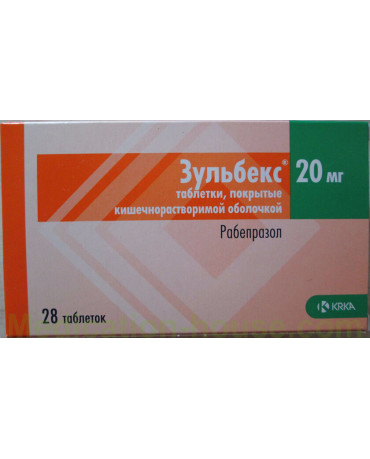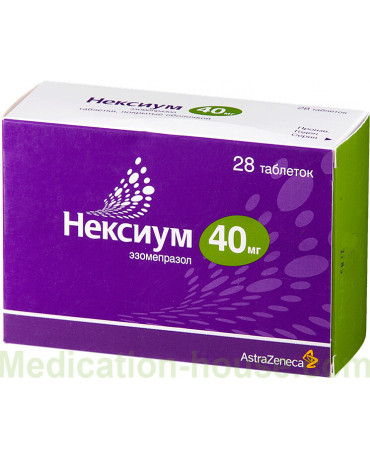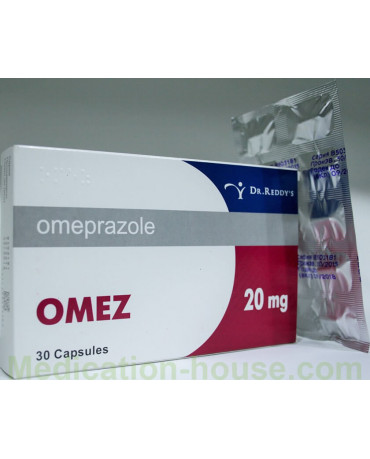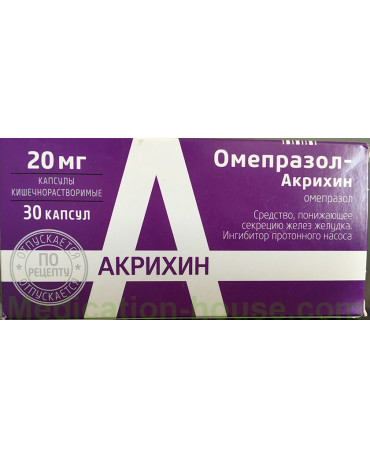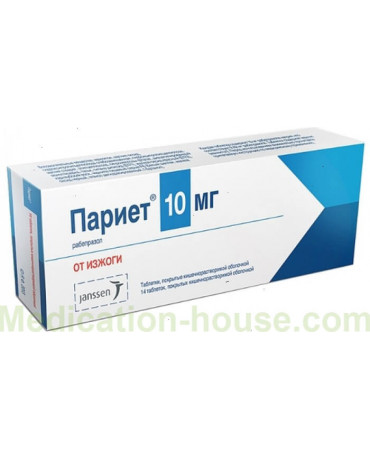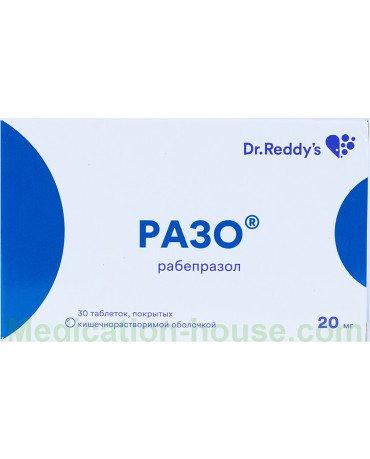Rabiet instruction
You can buy Rabiet here
Release form and composition
Dosage form - hard gelatin capsules: dosage of 10 mg - size No. 3, with a blue cap and a white body; dosage of 20 mg - size No. 1, with a lid and a blue body. The contents of the capsules are spherical pellets from almost white to white with a yellowish or creamy hue. Capsules are packaged in 5, 7, 10, 14, 15, 20 and 30 pcs. in blister packs, in a cardboard bundle of 1, 2 or 3 packs and instructions for using Rabiet.
Composition 1 capsule:
active substance: rabeprazole sodium - 10 mg or 20 mg (in the form of 8.5% pellets - 118 mg or 236 mg);
auxiliary components: sugar spheres (sucrose, povidone), talc, sodium carbonate, hypromellose, titanium dioxide;
composition of the pellet shell: cetyl alcohol, hypromellose phthalate;
capsule shell composition in a dosage of 10 mg: case - gelatin and titanium dioxide; cap - gelatin, titanium dioxide, patented black and blue diamond dyes;
composition of the capsule shell in a dosage of 20 mg: body and cap - gelatin, titanium dioxide, patented blue dye.
Pharmacodynamics
The active component of Rabiet is rabeprazole sodium, belongs to the class of antisecretory compounds, is a derivative of benzimidazole. It inhibits the secretion of gastric juice due to the specific inhibition of H + / K + -ATPase (a protein complex that functions as a proton pump) on the secretory surface of the parietal cells of the stomach. Thus, rabeprazole sodium inhibits the proton pump in the stomach and blocks the final stage of the formation of hydrochloric acid. The effectiveness of the drug is determined by the dose and, regardless of the type of stimulus, its action leads to the suppression of both basal and stimulated secretion of acid. Rabiet does not have anticholinergic activity.
After taking the drug at a dose of 20 mg, the antisecretory effect develops within 1 hour. 23 hours after taking the first dose, the degree of inhibition of basal and stimulated acid secretion is 69% and 82%, respectively, the effect lasts up to 48 hours. The duration of the pharmacodynamic effect of rabeprazole is much longer than predicted half-life (about 1 h), which is explained by the long-term binding of the drug to the H + / K + -ATPase of parietal cells of the stomach. The magnitude of the inhibitory effect of rabeprazole sodium on the secretion of hydrochloric acid reaches a plateau 3 days after the start of taking Rabiet. After its abolition, secretory activity is restored within 1-2 days.
A study on the effect of the drug on enterochromaffin-like cells involved 500 patients. They took rabeprazole sodium or a reference drug for 8 weeks. According to the results, no stable changes were found in the frequency of atrophic gastritis and the severity of gastritis, in the spread of Helicobacter pylori infection, intestinal metaplasia, and the morphological structure of enterochromaffin-like cells.
In a study on the effect of rabeprazole sodium on gastrin plasma levels, patients took Rabiet 10 and 20 mg every day for up to 43 months. In the first 2-8 weeks, the plasma concentration of gastrin was increased, which is explained by the inhibitory effect of the drug on acid secretion. Typically, gastrin levels returned to baseline 1–2 weeks after discontinuation of treatment.
In a study involving more than 400 patients who received rabeprazole sodium in a daily dose of 10 or 20 mg for 1 year, the incidence of hyperplasia was low and comparable to that with omeprazole (20 mg / kg). Not a single case of the development of carcinoid tumors or adenomatous changes observed in rats was recorded.
Also, in the course of the studies, it was found that when taking Rabiet at 20 mg / day for 2 weeks, rabeprazole sodium does not affect carbohydrate metabolism, the level of parathyroid hormone in the blood, thyroid function, and the concentration of testosterone, estrogen, follicle-stimulating hormone, luteinizing hormone, prolactin, cortisol, glucagon, aldosterone, growth hormone and renin. No systemic effects of the drug were found in relation to the central nervous, respiratory and cardiovascular systems.
Pharmacokinetics
Once in the intestines, rabeprazole is rapidly absorbed. The maximum plasma concentration reaches about 3.5 hours after a dose of 20 mg. Changes in maximum plasma concentrations (Cmax) and the area under the concentration-time curve (AUC) are linear in the dose range of 10–40 mg.
After a dose of 20 mg, the absolute bioavailability is approximately 52%. With repeated administration of Rabiet, this indicator does not change.
The half-life of the drug from plasma in healthy volunteers is 0.7–1.5 hours (on average - 1 hour). The total clearance is 3.8 ml / min / kg.
In chronic liver damage, AUC is 2 times higher than in healthy volunteers, which indicates a decrease in metabolism during the first passage through the liver. In addition, the half-life of such patients is increased by 2-3 times.
The time of taking the drug and the simultaneous use of antacids does not affect the absorption of rabeprazole. Fatty foods taken with Rabiet delay the absorption of rabeprazole for at least 4 hours, but the degree of absorption and maximum concentration do not change.
Communication with plasma proteins is about 97%.
After a single dose of 20 mg of 14C-labeled rabeprazole in healthy volunteers in the urine, an unchanged drug was not detected. Approximately 90% of the substance is excreted by the kidneys mainly in the form of two metabolites - a conjugate of mercapturic acid (M5) and carboxylic acid (M6), to a lesser extent - in the form of two unknown metabolites (were found by toxicological analysis). The remainder of the drug is excreted through the intestines. The total excretion is 99.8%, which indicates a slight elimination of rabeprazole with bile. The main metabolite is thioether (M1). The only active metabolite is desmethyl (M3), but it was detected in a low concentration and only in one patient who participated in the study after taking a dose of Rabiet 80 mg.
Special patient groups:
advanced age: the elimination of rabeprazole sodium is somewhat slower. After 7 days of taking the drug at a dose of 20 mg / day in elderly patients, the AUC was about 2 times greater, Cmax was 60% higher than in healthy volunteers of a younger age. Signs of cumulation of the substance were not observed;
CYP2C19 polymorphism: after 7 days of taking the drug at a dose of 20 mg / day in patients with a slow metabolism, the CYP2C19 AUC was increased by 1.9 times, the half-life was 1.6 times compared with patients who are fast metabolizers. In this case, Cmax increased by 40%;
chronic compensated cirrhosis: AUC rises 2 times, Cmax - by 50% compared with healthy volunteers. However, when taking the drug at a dose of 20 mg once a day, good tolerance to rabeprazole was noted;
stable end-stage renal failure in patients who require maintenance hemodialysis (creatinine clearance <5 ml / min / 1.73 m2): AUC and Cmax are approximately 35% lower than in healthy volunteers. Withdrawal of rabeprazole is similar to that of healthy volunteers (during hemodialysis - 0.95 hours, after the session - 3.6 hours). The clearance of the drug is about 2 times higher than that of healthy volunteers.
Indications for use
Rabiet 10 mg capsules are used to treat symptoms of dyspepsia associated with increased acidity of the stomach (including symptoms of gastroesophageal reflux disease), such as acidic belching and heartburn.
Rabiet capsules 20 mg are prescribed in the following cases:
peptic ulcer of the stomach and duodenum in the acute phase;
anastomotic ulcer;
reflux esophagitis;
erosive and peptic ulcer gastroesophageal reflux disease (GERD);
maintenance therapy for GERD;
non-erosive GERD;
Zollinger-Ellison syndrome and other conditions accompanied by pathological hypersecretion;
Helicobacter pylori eradication for peptic ulcer disease (in combination with antibiotic therapy).
Contraindications
sucrose / isomaltase deficiency, fructose intolerance, glucose-galactose malabsorption;
age up to 12 years - for the treatment of GERD, up to 18 years - according to other indications;
period of pregnancy and breastfeeding;
hypersensitivity to the components of the drug or substituted benzimidazoles.
With caution, the capsules should be used for severe renal failure.
Instructions for use: method and dosage
The capsules should be taken orally, swallowing whole (it is forbidden to grind or chew the capsules). Although eating and the time of use of the drug do not affect the activity of rabeprazole, the drug is recommended to be taken in the morning before meals, which contributes to better patient compliance with the treatment regimen.
For the treatment of symptoms of dyspepsia associated with increased acidity of the stomach, 10 mg capsules are prescribed once a day. The duration of treatment without consulting a doctor should not exceed 14 days. If within 3 days the therapeutic effect of Rabiet is absent, you should consult a doctor.
Recommended modes of use of capsules 20 mg:
anastomosis ulcer and exacerbation of gastric ulcer: 20 mg once a day for 6 weeks, if necessary, the duration of therapy is increased to 12 weeks;
exacerbation of duodenal ulcer: 20 mg once a day for 2-4 weeks, if necessary, the treatment is extended for another 4 weeks;
reflux esophagitis and erosive GERD: 20 mg once a day for 4-8 weeks, if necessary, the therapy is extended for another 8 weeks;
maintenance therapy of GERD: 20 mg once a day, the duration of treatment is determined individually depending on the condition of the patient;
non-erosive GERD without esophagitis: 20 mg once a day, after stopping symptoms to prevent recurrence, Rabiet should be taken 1 time per day as needed. If after 4 weeks of taking the drug the symptoms do not go away, the patient requires an additional examination;
Zollinger-Ellison syndrome and other conditions with pathological hypersecretion: the dose is selected individually. Treatment usually begins with a daily dose of 60 mg, then it is increased to 100 mg once a day or 60 mg 2 times a day, if fractional dosing of the drug is more preferable. The duration of treatment can reach 1 year;
Helicobacter pylori eradication: 20 mg 2 times a day in combination with antibiotics according to the scheme recommended by the doctor for 7 days.
Side effects
According to clinical studies, Rabiet is generally well tolerated. Emerging side effects are usually mild or moderate and are transient.
In clinical studies, the following adverse reactions were recorded:
from the digestive system: dry mouth, flatulence, diarrhea or constipation, abdominal pain;
from the nervous system: dizziness, headache;
other: skin rashes, peripheral edema.
The following side effects have also been identified during post-registration use:
from the digestive system: increased activity of liver enzymes; rarely - jaundice, hepatitis; in patients with cirrhosis - hepatic encephalopathy;
from the musculoskeletal system: rarely - arthralgia, myalgia;
from the hemopoietic system: rarely - neutropenia, thrombocytopenia, leukopenia;
allergic reactions: rarely - urticaria, bullous rashes, acute systemic allergic reactions; very rarely - Stevens-Johnson syndrome, toxic epidermal necrolysis, erythema multiforme;
others: rarely - hypomagnesemia; very rarely - gynecomastia, interstitial nephritis, increased risk of fractures.
Overdose
Cases of severe overdose are unknown.
When taking a dose significantly higher than recommended, symptomatic and supportive therapy is indicated. A specific antidote has not been established. Dialysis is ineffective because rabeprazole binds well to blood plasma proteins.
Special instructions
In patients receiving proton pump inhibitors (PPIs) for 3 months or more, in rare cases, symptomatic and asymptomatic hypomagnesemia are detected. Most of the messages came a year after the treatment. Of the serious side effects, arrhythmia, tetany, and seizures are noted. The majority of patients required the abolition of PPI and the appointment of treatment, including the replacement of magnesium. In this regard, with prolonged use of Rabiet or the simultaneous use of drugs that can cause hypomagnesemia (for example, diuretics or digoxin), patients need to control the concentration of magnesium in the blood.
During therapy, other PPIs and drugs that reduce gastric acidity, for example, H2-histamine receptor blockers, should not be taken.
Improving the patient's condition while taking Rabiet does not exclude the presence of malignant neoplasms in his stomach.
According to post-marketing observation, the use of PPIs may increase the risk of fractures of the wrist, spine or thigh associated with osteoporosis. The risk increases with the use of PPIs in high doses (exceeding those recommended in the instructions) for a long time (from 1 year).
Reception of Rabiet is a risk factor for the development of gastrointestinal infections, such as Clostridium difficile.
Patients in whom the symptoms of heartburn or digestive disorders are repeated, regular medical supervision is recommended.
If you need to take other over-the-counter medicines during the period of Rabiet's use, you should consult a pharmacist or medical specialist.
Patients should refrain from taking Rabiet before conducting a urea breath test.
Patients who require endoscopic examination should inform their doctor about taking rabeprazole.
When Rabiet is taken without a prescription for short-term symptomatic treatment of manifestations of non-erosive reflux disease or gastroesophageal reflux disease (for example, heartburn), it is recommended to consult your doctor in the following cases:
long-term treatment - for 4 or more weeks;
the appearance of new symptoms or a change in previously observed symptoms in patients over the age of 55;
weight loss, the occurrence of anemia, pain when swallowing, dysphagia, bleeding in the gastrointestinal tract, constant vomiting or vomiting with epigastric contents and blood;
history of impaired liver / kidney, jaundice, stomach ulcers, or stomach surgery.
People over the age of 55 who take OTC drugs daily to eliminate the symptoms of indigestion and heartburn should notify their healthcare provider about this.
Influence on the ability to drive vehicles and complex mechanisms
Given the pharmacodynamic parameters of rabeprazole and the profile of its undesirable effects, Rabiet's influence on the rate of reactions and the ability to concentrate is unlikely. Patients with drowsiness during the treatment period are advised to refrain from driving a car and performing potentially hazardous work.
Pregnancy and lactation
In reproductive studies, signs of impaired fertility and fetal developmental defects in rabbits and rats were not detected. However, in rats, the drug penetrated the placental barrier. There is no evidence to support the safety of rabeprazole in pregnant women. For this reason, during pregnancy, the use of Rabiet is contraindicated, unless the expected benefit of therapy for a woman is definitely higher than the potential risks to the fetus.
It is not established whether rabeprazole is excreted in breast milk of a woman, since relevant studies have not been conducted. Rabeprazole was found in the milk of lactating rats, therefore Rabiet is contraindicated for use during lactation.
Use in childhood
Rabiet capsules 10 mg, used to treat dyspepsia symptoms associated with increased acidity of the stomach, are not prescribed for children and adolescents under the age of 18 years.
The effectiveness and safety of 20 mg capsules in children from 12 years of age when used for the treatment of GERD has been confirmed by adequate and well-controlled studies for short-term treatment (up to 8 weeks). The safety and effectiveness of rabeprazole in pediatrics for other indications has not been established.
With impaired renal function
In severe renal failure, Rabiet should be used with caution. Dose adjustment is not required.
With impaired liver function
In mild to moderate impaired liver function, no significant differences were found in the incidence of side effects from that in healthy patients of the same gender and age.
At the first appointment of Rabiet, persons with severely impaired liver function are advised to exercise caution. Dose adjustment is not required, but it should be borne in mind that the AUC of rabeprazole sodium is about 2 times higher than in healthy volunteers.
Patients with severe hepatic impairment are advised to consult a physician before using Rabiet for independent symptomatic therapy.
Use in old age
Rabiet dose adjustment for elderly patients is not required.
Drug interaction
According to published data, in the case of taking rabeprazole simultaneously with methotrexate (mainly in high doses), an increase in the concentration of methotrexate and / or its main metabolite, hydroxymethotrexate, and an increase in its excretion time are possible. In this regard, if it is necessary to use high doses of methotrexate, the option of temporary cancellation of Rabiet should be considered.
In the study of combination therapy with antibiotics (amoxicillin, clarithromycin), some changes in the maximum concentrations of drugs and the area under the concentration-time curve were detected, but they were not recognized as clinically significant.
In vitro studies have found that rabeprazole inhibits cyclosporin metabolism with an IC50 of 62 μmol, i.e., at a concentration that is 50 times higher than the maximum concentration in healthy volunteers after 20 days of taking rabeprazole in a daily dose of 20 mg. The degree of inhibition is similar to that of omeprazole in similar concentrations.
Rabeprazole sodium causes a steady and prolonged suppression of the secretion of gastric juice, therefore, it can interact with medicinal substances, the absorption of which depends on the pH level. Atazanavir absorption is also pH dependent. And although its simultaneous administration with rabeprazole has not been studied, a significant decrease in its effect is expected. For this reason, concomitant use of drugs is not recommended.
Rabeprazole sodium is metabolized in the liver with the participation of the cytochrome P450 system (CYP450). However, in vitro the drug did not have clinically significant interactions with other drugs that are also metabolized by this system, such as warfarin, phenytoin, diazepam, theophylline.
Clinically significant interactions of rabeprazole with antacids were not observed.
Terms and conditions of storage
Store at temperatures up to 25 ° C in a dry place, protected from light and out of the reach of children.
Shelf life is 2 years.
Reviews
Reviews about Rabiet are mostly positive. Patients note that the drug effectively eliminates the symptoms caused by increased acidity of the stomach, has a long-lasting effect, is inexpensive.
Terms of sell
You don't need a prescription to buy Rabiet.


